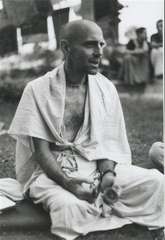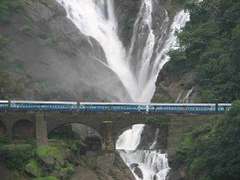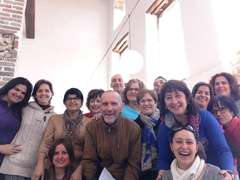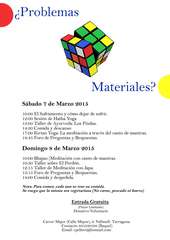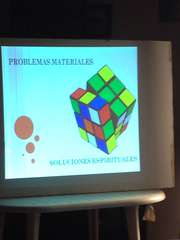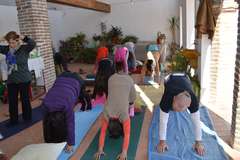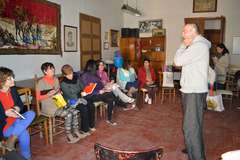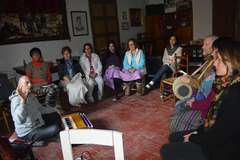Hare Krsna Gurumaharaja
Please, accept my humble obeisances
All glories to Srila Prabhupada
HpS - ASA - Paoho... !.
Dear Gurudeva, we had a week full of activity. On Monday we had a meeting with the national board. I think the balance was positive because the authorities were receptive to our proposals. Actually, they have two fundamental questions: they want to know whether the contents of our courses are related to the courses given by prabhu Jiva-sakti whom they recognize as the manager of education in the yatra. On the other hand, they want us to respect the controversial rule not allowing anyone to take the course of Bhakti-sastri, unless they have been initiated previously. We expressed some dissatisfaction with the standard but they agreed to discuss the item with us before long. In the next meeting, after the Vyasapuja of HH Jayapataka Swami, we will be defining issues related to the certificates backed by ISKCON and the permission to give our courses in Chosica and Lima temples, as appropriate.
HpS - ASA -- Very nice report. Seems to us these are significant points leading to having NIMSAR accepted as a Branch of ASA in Peru.
Yesterday we had a very long and productive day in Chosica where we talked extensively about "the incident" (my temporary resignation). The doubts were clarified, responsibilities were accepted and everything goes forward. We basically discussed the contents and agenda of the worship seminar by Gaura gadadhara mataji, the idea of traveling to different cities for a NIMSAR presentation in Arequipa, Cuzco, Puno, Huancayo and Guayaquil and the organization of the education meeting in August. I will be sending you the progress report as soon as possible.
Regarding to your request here is the result.
About the duties for the President, Secretary and Treasurer of NIMSAR:
President:
a) To represent the Association before all kinds of people, authorities and public or private entities.
b) Convene meetings of the Board, preside, direct the debates, suspend and terminate sessions.
c) Implement the resolutions of the Board, though it can perform all acts and contracts and sign any documents necessary for that purpose or delegate this responsibility to another member of the board if necessary.
d) Comply with and enforce the decisions of the Board.
f) Tiebraker vote in ties.
h) Perform such other duties that are inherent in its capacity as Chairman of the Board.
HpS - ASA --- The last one seems to be very ambiguous and I think should be eliminated. What do you think?
Secretary:
a) Attend meetings of the Board and draft and approve the minutes of those.
b) Perform the call to meetings, by order of the President, and citations of the members.
c) Receiving communication from the members of the Board such as notifications, requests for information, amendments, certifications or any other kind of messages.
d) Prepare the documentation that shall be used or considered.
e) Issue certificates of approved agreements and any other certifications, with the approval of the President, and the reports that are necessary.
f) To have the custody of the Archives, documents and books of the Association, except ledgers.
g) Any other functions inherent in their capacity as Secretary.
Again g) seems to be unclear and could be anything, no?
I would and iii) shall be responsible for sending and receiving all official communications of Nimsar
In cases of absence or illness and, in general, when any cause, the Secretary shall be replaced by the Treasurer.
Treasurer:
a) Raise funds of the Association, guard them and invest them in a manner determined by the Board.
b) Make payments, with the approval of the Board.
c) To intervene with his signature all documents of receipts and payments, with the assent of the President.
d) The keeping of accounting records and compliance with tax obligations in time and form, of the Association.
e) The preliminary draft budgets for approval by the Board. In the same way the accountability for annual approval by the board of directory.
f) Any other activities related to their status as treasurer, responsible for economic and financial management.
ASA - Look at BG 10.23!
As we have heard from Prabhupada etc.
1. Treasurer is to keep the assets of the organizations safe.
All the money received by the Oragnization must be given to the Treasurer and he must deposit it in the bank. Then funds can be released with the signature of both the Treasurer and President.
2. Keep record of where every penny comes from and where every penny goes to.
3. Generate Reports on the basis of 2. for organization and other bodies.
4. Generate Projections on the basis of 3 etc.
About the Statement of Requirements for the Membership in Nimsar:
1. Professional level. Set of academic and technical skills of the candidate able to contribute directly to the development of the NIMSAR project. Example: educators, administrators, accountants, journalists, lawyers, designers, marketers, engineers or technicians.
2. Devotional and vocational level. The applicant must be a devotee, whose faith does not depend on external circumstances, or not affected by the environment.
- A devotee whose vocation or nature is directed to education and do not do things to please others.
- A devotee who is a devotee everywhere in the temple, at home, at work, on the street.
3. Psychological level:
- NOI 3
- Maturity (liability), mental equilibrium (fortress-Vaishnava etiquette), desire for improvement (evolution or spiritual advancement).
- It [He] can work as a team (shown).
- Conciliator.
- Transparent, confidential and reliable.
- Breadth of perspective (optional).
About the NIMSAR members and their status:
- Founding members (honour title, no vote or opinion): Rohini dd, Goura gadadhara dd., Candramukhi dd., Yugala Kisora dd., Laksmana-agraja dasa, Patrak dasa.
- Board of directory (vote and opinion): Laksmana-agraja dasa (president), Gandharva dasa (secretary), Isvari dd. (treasurer).
- Directory (vote and opinion): Laksmana-agraja dasa, Candramukhi dd., Isvari dd., Abhinanda dasa, Yugala Kisora dd., Goura gadadhara dd., Patrak dasa (temporary resignation) and Gandharva dasa.
- Advisory board (to be confirmed, only opinion in specific issues): HH Hanumatpresaka Swami, HH Jayapataka Swami, Mathuresh dasa, Baladeva dasa, Om Kesavaya das, Govindanandini das, Omkara Krishna das, Vindiabali dd., Duiya dd. Gangamaji dd., Yamunesvara dasa and Jiva sakti dasa.
- Staff members (no vote or opinion): Padmavati dd., Nitya Kisori dd., Lila Sakti dd., Goura Karuna Sakti dd. and Bhaktina Isabelle.
We are waiting for your opinion and suggestions. Hoping you're in good health.
Your servant
Gandharva dasa
NIMSAR Secretary
HpS - Hmmm. I am used to how it is done in USA. The ultimate authority is the Board of Directors. They chose the the Officers: President, Secretary, Treasurer [and others, eg. Vice-Presidents with specific port folios]. They give general and specific instructions to the Officers. Of course one can be a Director and Officer also.
President - Chief Excecutive
Secretary - Communication
Treasurer - Assets
Directors, Officers and Members
Members can be classified in different ways, but one important distinction should be Voting [for Directors] and Non-Voting Members.
What about this model?
This is very important work, but main thing is that we all chant Hare Krsna, Dance and honor Prasadam.

